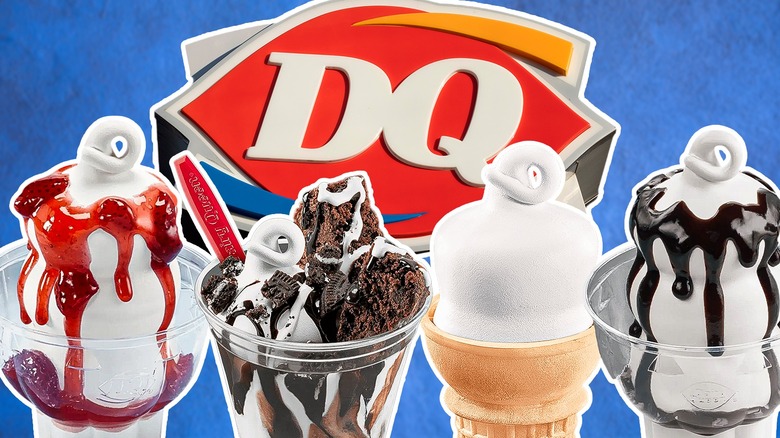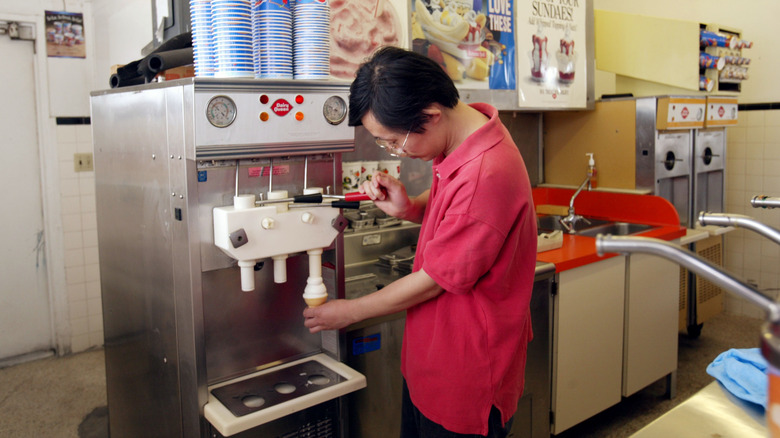Dairy Queen Doesn't Sell Real Ice Cream. So What Is It?
Dairy Queen is one of the original pioneers of soft serve. Its co-founder, J.F. McCullough, is credited by some as having invented the first soft serve machine in 1938 (other accounts attribute the invention to Tom Carvel of rival brand Carvel). The fact that the first Dairy Queen location opened along historic Route 66 only served to cement soft serve as the quintessential fast food dessert. Each swirly cone from Dairy Queen is a piece of dessert history, but it isn't technically ice cream.
Soft serve is a wholly distinct type of frozen dessert, which is why Dairy Queen got so popular in the first place. It didn't look like any kind of ice cream people had eaten before, inspiring one of the company's earliest slogans: "The cone with the curl on top." DQ's famous soft serve became the basis for future sweet successes like the Dilly Bar and the Blizzard.
Although the company would go on to serve a full selection of fast food, its sweet treats remain among the most popular Dairy Queen menu items. Dairy Queen will always be the first name that comes to mind for some people when they think of soft serve, and deservedly so, as the chain helped popularize it. However, while it is commonly referred to as "soft serve ice cream," Dairy Queen's soft serve isn't real ice cream — at least, not according to the U.S. government. Why? The chain's creamy, icy confection isn't fatty enough.
Dairy Queen's soft serve doesn't meet the fat requirement for ice cream
If you read through a Dairy Queen menu, you won't find the words "ice cream" anywhere. The reason for this lies in the Code of Federal Regulations, where Food and Drug Administration (FDA) guidelines state that "ice cream contains not less than 10% milk fat." Dairy Queen's soft serve only contains 5% milk fat, which means that it doesn't meet the government's definition of ice cream, and it must be sold under a different name.
Dairy Queen has used the same soft serve recipe since it opened, so despite what many may believe, the famous chain's signature product has never been considered ice cream. (The company briefly tested "Queen's Choice," a line of hard ice cream launched in 1981, according to The New York Times, but ultimately abandoned the product line.) The FDA used to classify Dairy Queen soft serve and similar confections as "ice milk," which included frozen desserts with a milk fat content between 2.5 and 10%. However, in 1995, federal regulations were changed, and products formerly recognized as ice milk were reclassified as reduced-fat, light, or low-fat ice cream, depending on the fat content. Dairy Queen's soft serve now qualifies as "reduced-fat ice cream," but that's still different from ice cream in the eyes of the government, which is still defined as having at least 10% milk fat. And fat content isn't the only thing that makes soft serve and ice cream unique from one another.
How is soft serve different from ice cream?
The difference in milk fat is the key distinction between Dairy Queen soft serve and ice cream, and an important part of the difference between soft serve and custard, another ice cream cousin. As important as this is, not every brand of soft serve fails to meet the FDA's standards for ice cream. There are some soft serve brands that do contain 10% milk fat, although it is more common for soft serve to fall into the reduced-fat category, like Dairy Queen. To the consumer, the most obvious difference between soft serve and other frozen desserts is the airy texture. Soft serve is between 40% and 45% air, which gives it a light texture that sits somewhere between ice cream and whipped cream. Of course, this also allows the manufacturer to stretch their ingredients further, producing more servings for less.
You can't have soft serve without a soft serve machine, which is integral to maintaining that perfect, fluffy texture. After the base ingredients are loaded in, the machine churns the soft serve and combines it with air. The machine also holds the soft serve at a temperature just below freezing, around 25 degrees Fahrenheit. Compare this to the home freezer where you store regular ice cream, which should be set to between -5 degrees Fahrenheit and 0 degrees Fahrenheit. As useful as they are, soft serve machines are a nightmare for fast food safety and must be cleaned frequently.


